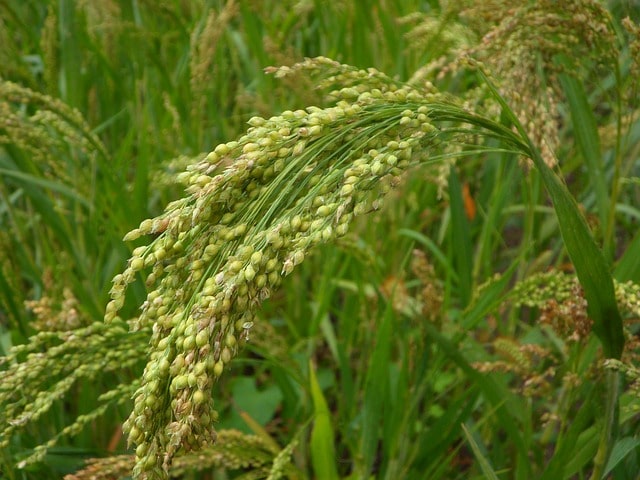There are many species of millet but the most important is Pennisetum typhoides which is known as Bulrush or Pearl millet.
Among cereals, it is the crop of the driest region. It is very drought resistant and gives reasonable yields in infertile sandy soils, which would be unsuitable for other important cereal.
The total production of millet in tropical Africa is somewhat smaller than sorghum.
Most of the production are in the drier areas of Nigeria, Burkina Faso, Senegal, Chad Sudan, Mali and Niger.
Origin
There seems little doubt that tropical Africa is the home of millet.
It probably originated in the semi-arid savanna (Sahel zone) of Africa, where the greatest number of wild and cultivated forms occur.
It is widely grown throughout the tropics and subtropics of Africa and Asia.
Ecology
The crop is grown mainly in the Sahel zone. Although it is drought resistant and suited to sandier and drier areas than sorghum, it requires a certain minimum amount of moisture for growth as it does not possess the facility of remaining dormant during periods of drought as does sorghum.
However, too much rain at flowering can cause a crop failure. High temperatures are required to mature the crop.
It is the number one crop in the Sahel savanna zone approaching the Sahara in tropical Africa.
It can be grown on a variety of soils but light loamy soils are preferred, it cannot tolerate waterlogging but can grow in soils too poor to support other cereals.
It is a short -day crop although there are some day -neutral cultivars.
Botany
It is a tall erect annual grass which is free tillering and grows up to 4m tall.
The roots are adventitious and prop roots arise from nodes just above the ground.
The stem is solid; tillers or true lateral branching may occur depending on cultivars.
The nodes are prominent with ring of silky hairs. The leaves are lanceolate with well developed mid-rid.
The inflorescence is a contracted terminal panicle with a central rachis bearing densely packaged clusters of spikelets. The spikelets are usually borne in pairs.
The styles protrude and dry up before anthers from the hermaphrodite flowers emerge.
The plant is thus markedly protogynous and cross-pollination normally occurs.
Where there is some overlapping of the female and male phases in the same inflorescence or in different inflorescences on the same plant, some self a pollination can occur and seed may be set when the head is bagged.
The fruit is a caryopsis and varies in color from white, yellow, grey or light blue.
The varieties can be classified into 3 types:
- Gero is a short season variety taking 90 days to maturity.
- Maiwa is a longer season millet, taking up to 120 days to maturing.
- Dauro is a transplanted long season millet, which generally grows shorter than Maiwa.
Cultural practices
Propagation of millet is from grains at the seeding rate of 10-15 kg/ha. Plant spacing is 75x25cm but may be wider if inter-cropping is contemplated.
The crop may be grown on the flat or on ridges, the latter being necessary where waterlogging may occur.
‘Gero‘ millet is planted at the onset of the rains and ‘Maiwa 3-6 weeks later. ‘Dauro‘ millet is transplanted three weeks after sowing in nurseries.
Millet responds well to the application of fertilizers especially N. Fertilizers which can be applied at the rate of 300-400 kg/ha of NPK, 2-3 weeks after planting.
Weeds can be controlled manually at 3 and 7 weeks after sowing. Atrazine at 2 kg a.I/ha or gardoprin A(atrazine terbuthylazine) at 1.5-2.0kg a.I/ha can be applied pre-emergence.
Harvesting
The crop comes into maturity from 90 days. The crop is harvested when the grain is fully ripe by cutting off the heads.
In some heavy tillering CVS, with uneven ripening, two or more harvests may be necessary. The ears are threshold by beating with sticks. The threshing percentage is about 55.
Yields
Farmers’ yields range between 450 and 1500kg/ha of grain. Under improved cultural practices, yields of 2000-3500 kg/ha are possible.
Storage
The grain stores very well and is much better in this respect an sorghum or maize.
Chemical composition
The air-dried grains contain approximately 12.4% water, 11.6% protein, 5.0% fat, 67.1% carbohydrate, 1.2% fibre and 2.7% ash.
Uses
- As staple food in drier parts of West Africa; cooked or made into flour for porridge.
- It can be used to produce malt and the malted seed is an important source of beer.
- The grains may be fed to poultry and other livestock.
- The green plant can be used as fodder.
- The straw may be fed to livestock or used for bedding, thatching, fencing and fuelling.
Diseases
Downy mildey, smut and ergot are the major diseases.
- Downy mildey
Downy mildew or green ear is caused by Sclerospora graminicola is the most serious disease of millet.
The disease is noticed often only by the green ear symptom. The primary infection is through soil-borne zoospores and high humidity helps in the spread of the disease.
Control is by early planting, burning infected plants and crop residues, crop rotation and development of resistant cultivars.
- Smut
Smut is caused by Tolyposporium penicillariae and is serious in cloudy weather combined with high humidity during flowering.
Severely infected ears should be burnt. Seed treatment with thiram kills the spores sticking to the seed surface and reduces seed-borne infection.
- Ergot
Ergot is caused by Clavicens microcephala. It affects spikelets, which are transformed into sclerotia and grain formation is inhibited.
The spread can be reduced by using seeds free from sclerotia for sowing.
Pests
The most common insect pest of millet in Nigeria are stem-borers (Acigena ignefusalis) and millet midge (Geromyia penniseti).
Other pests include birds, which attack the fruiting heads in large numbers. Millet is attacked by Striga app. but the parasite is not as serious as it is on sorghum.








